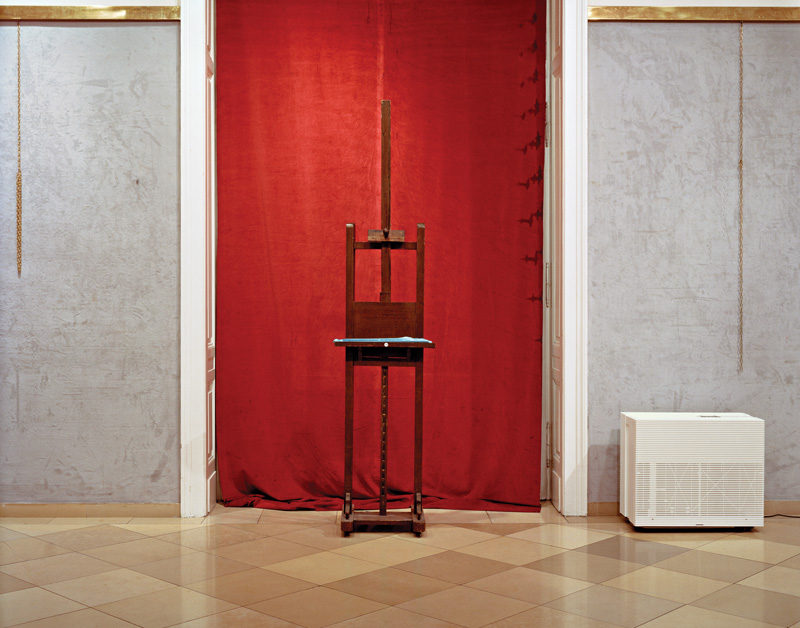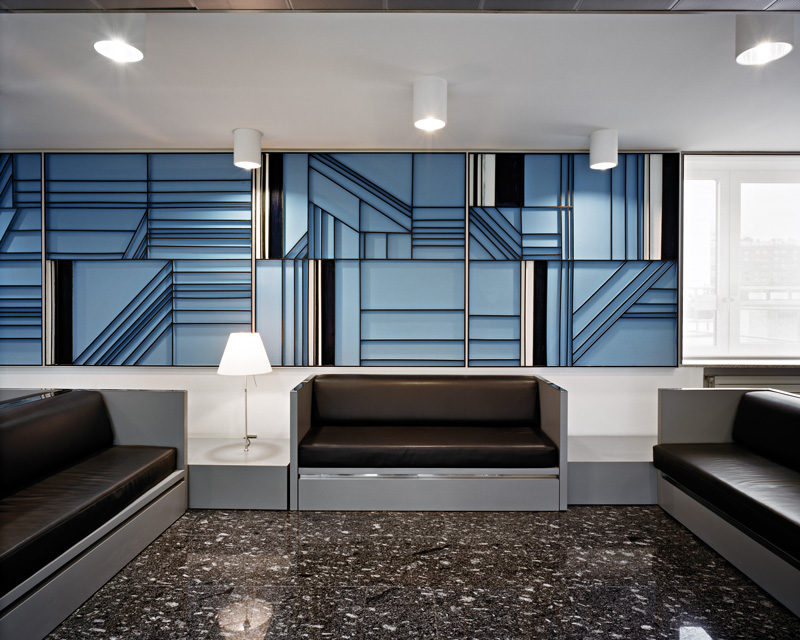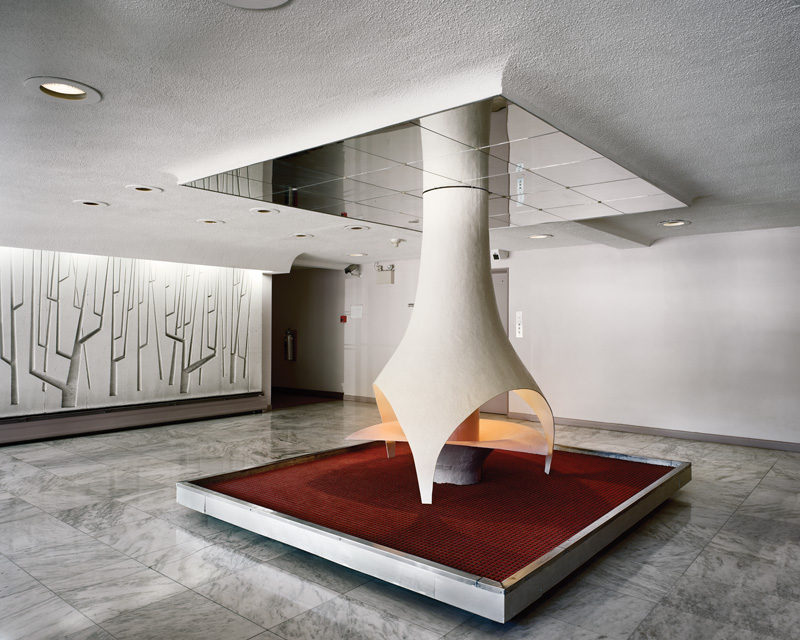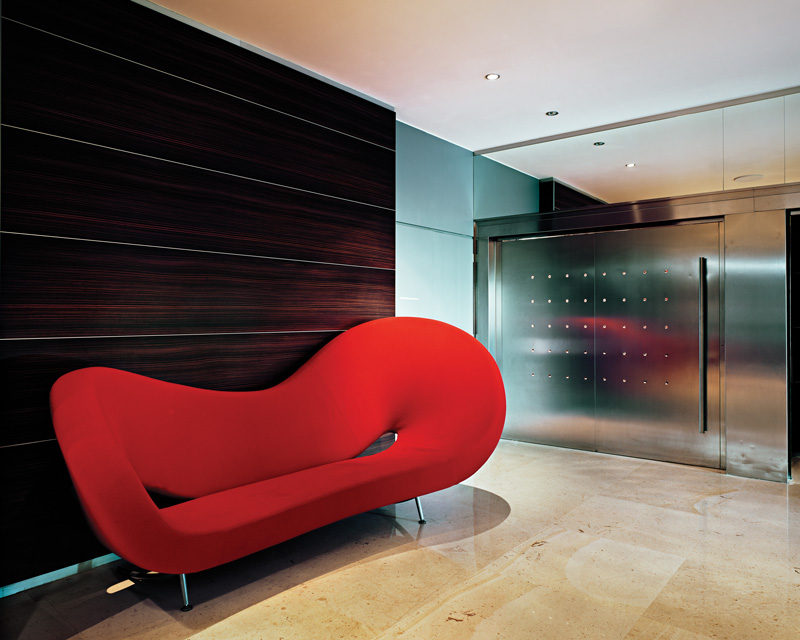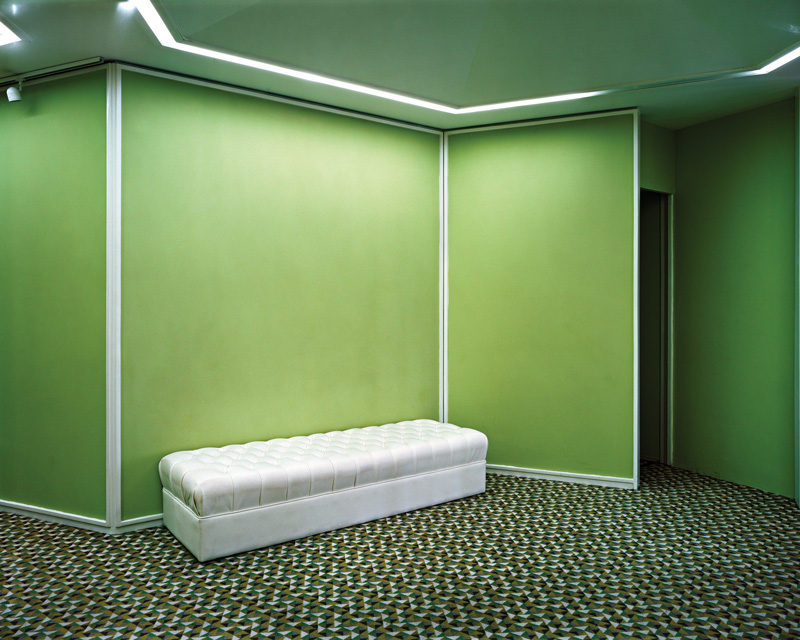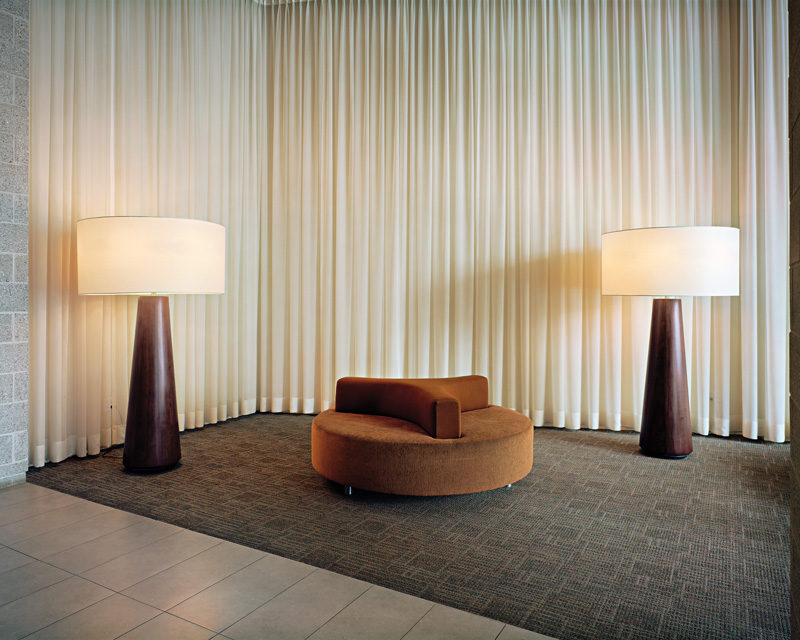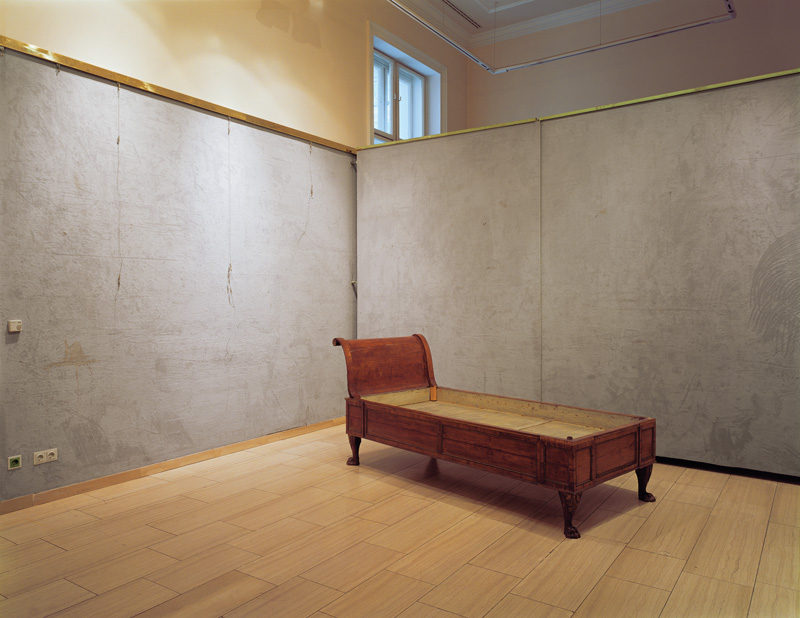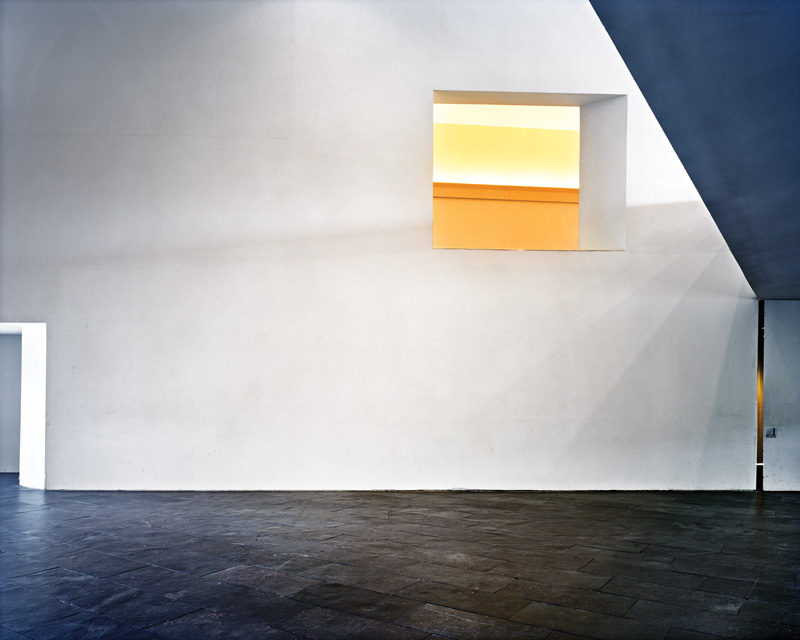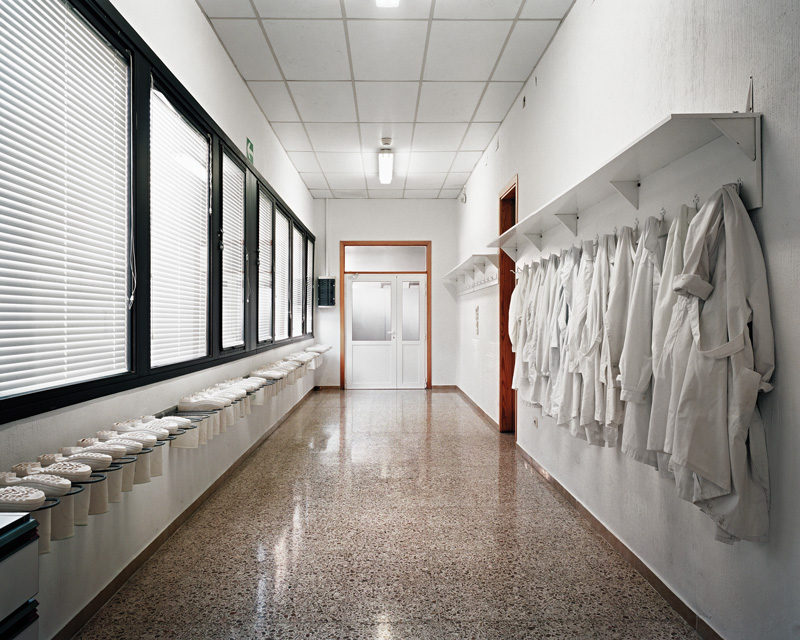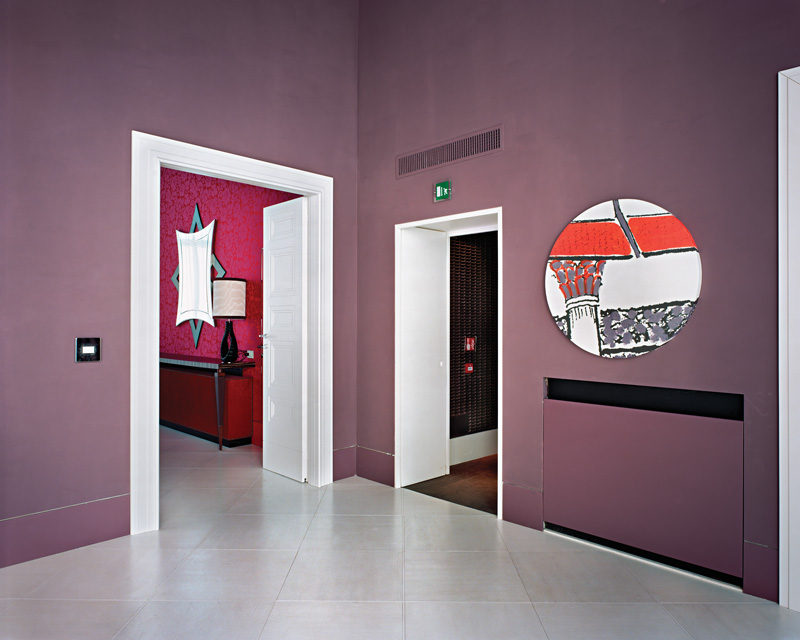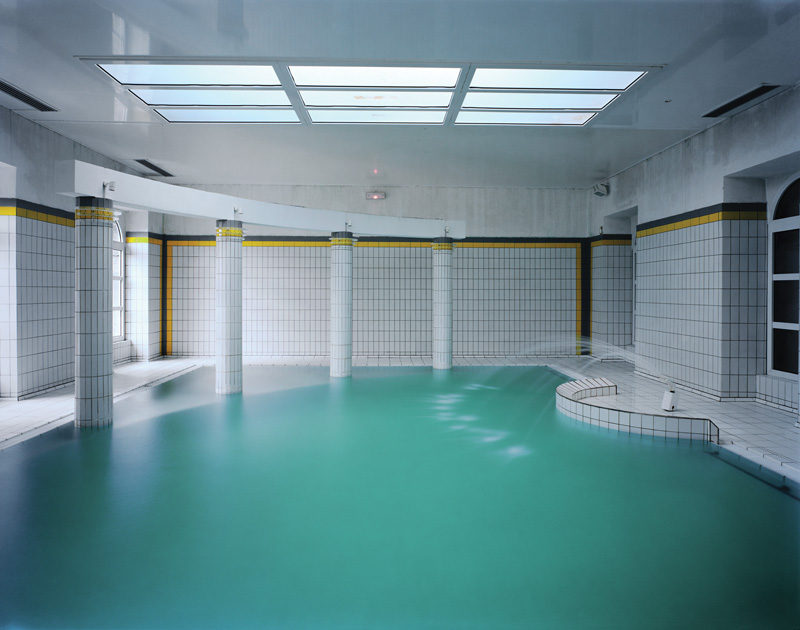by Stephen Horne
Lynne Cohen has been photographing generic architectural interior spaces for several decades. Photographing rooms is, and has always been, her subject. Some of these rooms are health spas, classrooms, and hotel lobbies, while others are more sinister – laboratories, control rooms, and military sites. In a Cohen photograph, however, even an innocent health and relaxation facility can appear in an unusually “posed” mode. For example, in Spa (1999) we encounter a theme that has shown up throughout Cohen’s decades-long art practice. In this photograph, a view opens out into a room that is, in actuality, as much absent as present. It is an image of a room that has been fitted into or onto space like a projection. Classical columns support an architrave. The ensemble is free-floating, an architectural quote. The architrave with its columns neither supports nor connects any structural tectonics. Like the photograph that we are viewing, it is a projected reflection. And by this same path, our own placing with respect to time and space is configured in the mode that we commonly call “artificiality” – by way of illusion rather than having been built with real materials. If the columns quote, it is from an elsewhere in place and time and this displacement is something intrinsic to photography. And so this room, Cohen’s subject, presents itself ontologically just as a photograph does. Its “elsewhere” is also its “here,” its presentness is a mode of absence, and Cohen uses this to give us a deeper intuition of photographic realism’s rhetorical basis in ambiguity and paradox.
A recent work, Untitled (White Boots) (2010), demonstrates Cohen’s allegiance to seeing the extremes that rest in our typical environments. This image places us in a hallway, looking down into the deep space of a corridor toward an exit door at the distant end. This is a clinical and ordered space, perhaps belonging to a production laboratory or other technical facility. On one side, racks hold white lab coats hanging in series, and on the opposite wall windows with blinds down run the full length of the corridor. As is frequently the case with Cohen’s photos, this one documents an in-between sort of space but one that conforms to a strictly rational model of organization. Every surface is constructed to a grid: even the shining terrazzo floor reveals such hints. Production-line order is the ambience here. For all we know, this could even be a facility where technical images are produced. Again, as a mise-en-scène there is the ambiguous sense that something may happen, or is happening invisibly – or, conversely, that absolutely nothing will ever happen, the site being suspended outside of any past or future.
What there is to see in Cohen’s photographs is the mode of seeing that is photography. The craft of photographic transparency is here preserved by way of artistic opacity. Opacity emphasizes the “made,” shifting attention toward a performative, activated relationship between observer and observed along the lines articulated by Barthes in his “death of the author” moment.
This image, like most of Cohen’s photographs, is typical for its inclusion of the various grids that her chosen sites offer. In White Boots she has placed her camera centrally looking down a long corridor. Both floor and ceiling are marked by the grids of tiles, and these grids recede to a vanishing point in the doorway at the distant end of the corridor.
Another recent work, Untitled (Red Cushions) (2009), places us looking into the corner of a room, probably a waiting area of sorts. The room is empty except for its furnishings, and this emptiness exaggerates our view into a nearly symmetrical composition with a vanishing point through one of three chairs that are positioned almost symmetrically in the room and gathered around a circular rug and circular table. This compositional ordering renders the space un-stable, dynamic, and ultimately theatrical, a mise-en-scène. Looking into this space, we may find ourselves “cornered.” As a waiting area, it offers a particular social scenario, that of being trapped in the room, and this is ultimately the sense of the photograph itself; it holds us, arrested or “cornered,” in photographic suspension. Perhaps even more important is Cohen’s continuing emphasis on the grids that support both her image and the construction of the photographed room spaces. In this case, as the trajectory of the white tiled floor rises toward the centre of the image its grid pattern slopes slightly downward toward the left corner, and this spatial incongruity reflects the positioning and angling of the camera. This aspect of framing is both on the side of the “made” and the “found” in terms of how a photograph appears. The camera delivers the frame “readymade,” while at the same time it is subject to the artist’s creative taking of a viewpoint (made).
It is possible, and perhaps rewarding, to propose two different trajectories within Cohen’s work. There are the more “disturbing” images, such as White Boots, with its clinically oppressive perspectival construction, and images with maniacally incongruous construction and décor features, such as Circle (2011). The difference between the two directions suggests a question regarding Cohen’s selection of sites for photographing. Some of her sites are called “control rooms,” “laboratories” or “military installations,” while others are the more innocuous “spas,” “lobbies,” or corridors and transitional places that make up the everyday environment. Obviously, the images could be sorted by subject classifications and groupings that would supply either a topical, even documentary meaning, or an embrace of ambiguity and self-referential opacity. Were they to lack irony, would these photographs be received as documentary work of an architectural or cultural and anthropological sort? Irony is, of course, the distancing functioning in the neutral, obscure, or detached images; it is the “play” that Greenberg identified with a medium’s opacity and in which he located the possibility and indication of social dissent. On the other hand, the topic of irony opens the question of artistic autonomy and we slide into the territory of Michael Fried’s recent taking of photography onto the walls of the art museum. Can the museum as destination handle photography’s ontology of realism? Can photography handle the museum as destination without becoming merely the convenient tool of conceptual artists?
What there is to see in Cohen’s photographs is the mode of seeing that is photography. The craft of photographic transparency is here preserved by way of artistic opacity. Opacity emphasizes the “made,” shifting attention toward a performative, activated relationship between observer and observed along the lines articulated by Barthes in his “death of the author” moment. Emphasizing the “made” in photography means considering the temporality that a photograph is, and this is a path toward understanding the materiality of a photograph. Cohen refers to her subjects as “readymades” or “installations.” Although this seems accurate when applied to the subject of her images, these terms could also refer to the machinic, automated dimension of photography. Such an emphasis detracts from the “made” dimension of photography, tending toward an indexical grounding of transparency and documentary factuality. As photographs, her images document a “found” scene, but ultimately her production itself falls on the side of the “made” rather than the “found.” The emphasis is thus on creating subtle tensions between the already existing or “found” photographic aspect of her subject and the photographer’s play with the realm of photographic technicity. Cohen’s photographs are not ciphers, but present a complex resistance to conceptualization – that is, to being disposed of as cultural references – resting instead on photography understood as embodying a history of perception, a history that includes the photographic constructedness of contemporary reality.
Lynne Cohen recently received the first Scotiabank Photography Award for her body of work, which, since the early 1970s, has celebrated the sense of strangeness particular to public and institutional sites. This award crowns a successful career that includes a retrospective exhibition at the National Gallery of Canada in 2001, a Governor General’s Award in Visual and Media Arts in 2005, the publication of a monograph by Le Point du Jour in 2009, and participation in the Rencontres photographiques d’Arles in 2011. A sixth monograph devoted to her work is about to be published by Éditions Steidl, and she will have a solo show at the CONTACT Photography Festival in Toronto in 2012. Cohen is represented in Canada by Galerie Art 45 (Montreal) and the Olga Korper Gallery (Toronto). She lives and works in Montreal. http://www.lynne-cohen.com/
Stephen Horne is an artist and a writer whose essays have appeared in periodicals (Third Text, Parachute, Art Press, Flash Art, Canadian Art, C Magazine, Fuse) and anthologies in English, French, and German. He edited Fiction, or Other Accounts of Photography (Montreal: Dazibao, 2000) and published Abandon Building: Selected Writings on Art (PressEleven, 2007). Horne was an associate professor at NSCAD from 1980 to 2005 and taught MFA seminars at Concordia University from 1992 to 2000. He currently lives in France and Montreal.

